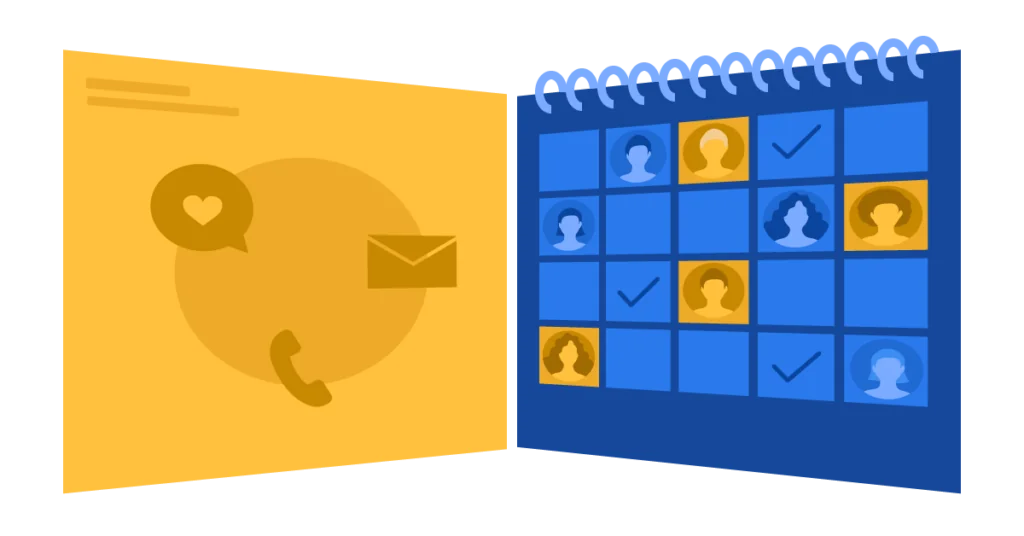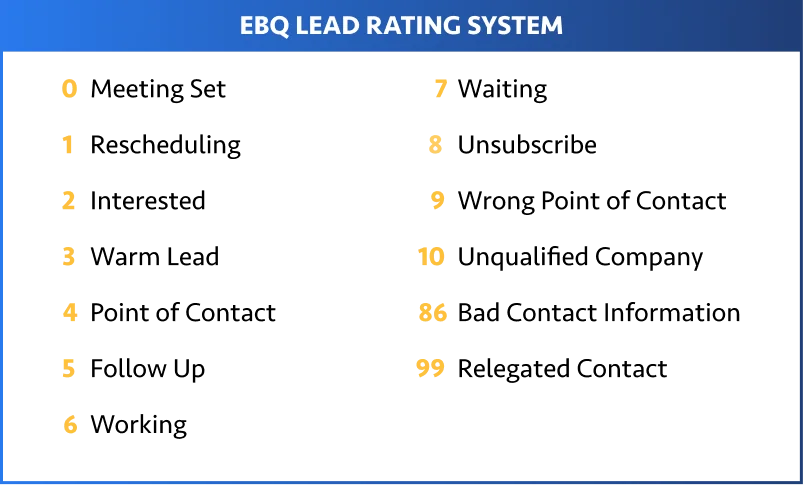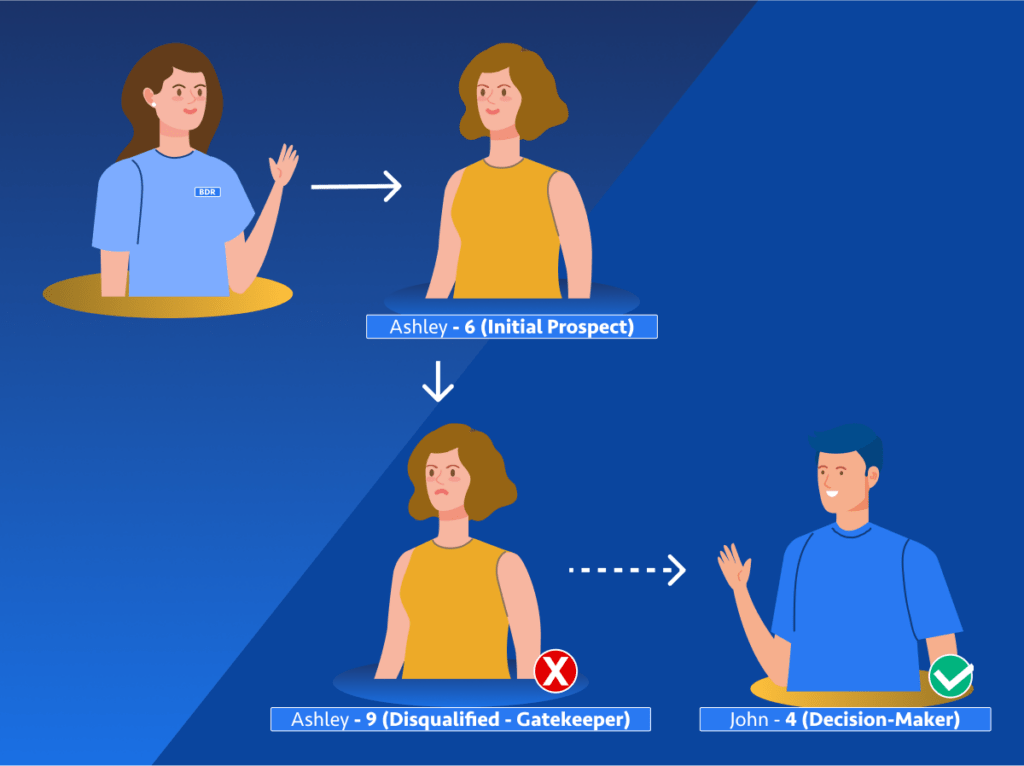Lead Qualification: Definition, Tips, and Key Steps to Master It


Tim Edwards
This post was originally published in July 2018 and has been updated for accuracy and comprehensiveness.
With multiple prospects entering your system, your business development reps (BDRs) need an efficient yet objective way to measure how close a prospect is to converting. By understanding the definition of lead qualification and how it can positively impact your sales process, you can better identify high-quality leads.
In this chapter, we’ll go over:
- What is lead qualification?
- How to qualify a lead
- Why should you qualify leads?

Download the Ultimate B2B Appointment Setting Guide
Don’t have time to read the whole guide right now? Download the PDF version of the guide.
What is lead qualification?
A lead qualification system is a numeric point system assigned to each prospect to gauge how close they are to closing.
Properly qualifying a lead allows you to:
- Provide a quantitative way to measure a prospect’s likelihood of converting
- Standardize how you define a qualified lead
- Improve your sales-marketing alignment
- Promote better note-taking for improved visibility
- Allow for a more accurate sales projection
We will expand on a few of these points later in this chapter.

Subscribe to EBQ's Bimonthly Newsletter

Subscribe to EBQ's Bimonthly Newsletter
How to qualify a lead
Here are the five steps to qualify a sales lead:
- Develop your lead qualification system
- Assign actively engaged prospects with a preliminary score
- BDR reaches out to the prospect and scores
- BDR follows up and rescores the prospect
- Repeat until the prospect is qualified or disqualified
Your lead qualification process can be updated at any time to reflect on your current best practices. Make sure to record your lead qualification system in an SDR playbook to standardize how you are separating a qualified lead from an unqualified one.
1. Develop your lead qualification system
Your lead qualification system must have:
- A clear criteria for qualification
- A sliding scale to indicate how close a prospect is to converting
- A succinct definition of when a prospect is disqualified
Most importantly: your BDRs must be trained to follow these rating systems closely. Otherwise, you will confuse your sales team — thus defeating the purpose of creating a system with strict guidelines.
From here on, we will be using our EBQ Rating as an example:

You’ll notice how granular the EBQ Rating is compared to other traditional lead qualification systems. This allows our sales and marketing teams to manually disqualify prospects and quickly give a reason within our notes.
EBQ Tip: You need a single source of truth that all BDRs can access, such as a CRM platform. We prefer using Salesforce because of its powerful reporting capabilities to promote better transparency across all teams.
2. Assign actively engaged prospects with a preliminary score
As mentioned earlier, there may be thousands of prospects in your database right now. However, a BDR team can not work on all these records simultaneously.
We created 6’s (Working) and 7’s (Waiting) to clearly distinguish the prospects that our BDRs are actively working on.
EBQ Tip: Did you know that bad sales data can waste 25% of your BDR’s time?
To mitigate that risk, make sure you are choosing the right data vendor. These data specialists should manually verify contact information before sending the list to your sales team.
3. BDR reaches out to the prospect and scores
Your BDR will make their first outreach attempt and score the prospect’s quality based on the EBQ Rating. This will dictate which touch cadence your BDR will put your prospect through to ensure adequate follow-ups with less friction.

For Example:
Your BDR is reaching out to Ashley, a prospect from XYZ Company. Ashley is first labeled a “6”.
After contact is established, your BDR discovers that Ashley is just a gatekeeper — rendering her a “9”. She should not be contacted again since she is disqualified as a prospect.
However, Ashley tells you that John is the true decision-maker within the XYZ company. Your BDR enters John into your CRM and labels him a “4.”
4. BDR follows up and rescores the prospect
In the BDR world, persistence is key. After all, it takes up to 5 follow-up attempts before a typical B2B buyer says “yes.”
Based on how well the most recent conversion went, the BDRs will rescore the prospect using your lead qualification rating. The prospect continues down the sales cadence until they reach the end of the cycle.
5. Repeat until the prospect is qualified or disqualified
In other words, you should continue following up on a prospect until they are labeled a “0,” “9,” “10,” or “99” in the EBQ Rating system.
To increase your chances of securing a sales meeting, consider these 5 tips:
- Review common objections and responses before reaching out
- Ensure your BDRs have access to the sales rep’s calendar for a better handoff experience
- Record best practices in a centralized knowledge base
- Keep your CRM up to date for better visibility
- Align your sales and marketing teams on how your lead qualification system works
EBQ Tip: Within the EBQ Rating, an “8” indicates a prospect has unsubscribed from marketing messages. You can use the EBQ Rating to segment your email marketing audiences and create an automation rule that automatically sets all “8’s” as “Do not email.”
Why qualify leads?
We mentioned earlier how a lead qualification system allows for better team alignment and provides an objective view of how close a prospect is to converting.
However, three key benefits are worth expanding on.
1. Encourages better note-taking
Many BDRS internalize their conversations with prospects and only take brief notes when recapping a call. If that BDR leaves your organization, they take their tacit knowledge with them — leaving you open to major knowledge gaps about your existing customers.
By requiring notes in a CRM custom field, your BDR has to explain why they scored them a particular way to the rest of the lead generation team. Additionally, the CRM will store these notes — even if that BDR leaves your organization.
2. Seamless integration with marketing automation
Your marketing team can use your lead rating system to better segment your audience as well. A lead qualification system allows you to automate several touchpoints based on how the prospect engages with your marketing assets such as emails, landing pages, content, and forms. Your marketing automation specialists can leverage smart campaigns that respond to prospect actions.
3. Allows for better sales projection
Finally, qualifying leads allow you to quickly identify engaged prospects so you can accurately measure sales pipeline activity to predict sales growth.
For example, let’s say that a client has a database of 10,000 cold prospects and they hire EBQ to qualify the prospect database. EBQ then identifies 300 interested leads after their calling efforts, all with an ASP of 50,000 and an average closing rate of 20%. As a result, the company would be able to make a case for $3,000,000 in additional revenue in the pipeline to the venture capitalist.

Download the Ultimate B2B Appointment Setting Guide
Don’t have time to read the whole guide right now? Download the PDF version of the guide.
The Lead Qualification Process: Simplified
We recommend using our EBQ Rating to better qualify your leads. You’ll want to:
- Develop your lead qualification system
- Assign actively engaged prospects with a preliminary score
- BDR reaches out to the prospect and scores
- BDR follows up and rescores the prospect
- Repeat until the prospect is qualified or disqualified
If you want to grow your sales pipeline, consider partnering with our outsourced lead generation team. At a fraction of the cost of hiring internally, we can prospect, nurture, and follow up on your leads for you. Better yet, we use our proven processes and seamlessly integrate them with your business — empowering you to accelerate your sales and marketing efforts.
